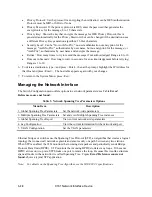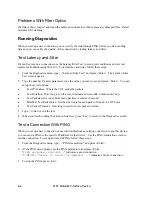
Chapter 4
Maintenance and Troubleshooting
General Maintenance and Managing Cable Links
Well-maintained components and clearly identified cables help assure optimum system operation.
Damaged fiber cables and dirty connectors are a common source of signal loss or attenuation. Single
mode and multimode fiber optics are especially sensitive to contamination. Inspect, clean, and test all
components to maintain optimum performance.
Note: To avoid damage and signal loss, do not over-tighten or force-fit optical connectors.
•
To clean the ferrules and end-face surfaces of male fiber couplings, use a lint-free pad saturated
with isopropyl alcohol.
•
To clean the female fiber connectors, use canned air.
•
To prevent damage and contamination, place protective dust caps on all unused optical
connectors.
Plan to manage the cables to ensure trouble-free operation and maintenance tasks.
•
Position and secure the fiber optic cables to prevent excessive bends and damage. Follow the
guidelines for the bend radius for specific fiber cables.
Note: If no minimum bend radius is specified, the typical long-term, low-stress radius is not less
than 15 times the cable diameter (based on Federal Standard FS-1037C).
•
Always connect the fiber optic cables in the standard Tx to Rx and Rx to Tx scheme.
•
Label each cable near each end with the signal direction, source, and destination to minimize
connection errors.
Checking Optical Power Levels
To ensure the proper performance levels, measure the fiber link loss, or link attenuation, for all fiber
links. Each 9161 is shipped with a document that lists the output power for each laser transmitter. To
determine link attenuation, use either the 9161 Tx source or a hand-held 1310/1550 nm laser source, a
fiber optic test jumper cable (with known loss), and an optical power meter.
Note: For accurate results, warm up each unit for at least 30 minutes before checking power levels.
The transmission laser in the 9161 turns on automatically when the chassis receives power.
Measure Transmitter Output Power
To measure the output power, follow these steps:
1. Clean the connectors on the fiber optic test cable, then plug it in to the Tx connector on the 9161.
2. Warm up each component for at least 30 minutes.
9161 Network Interface Device
4-1
Summary of Contents for 9161
Page 1: ...the 9161 Network Interface Device User Manual...
Page 2: ......
Page 4: ......
Page 6: ......
Page 10: ......
Page 41: ...9161 Network Interface Device 3 27 3 22 Blank...
Page 42: ......
Page 50: ......
Page 52: ......
Page 53: ......












































